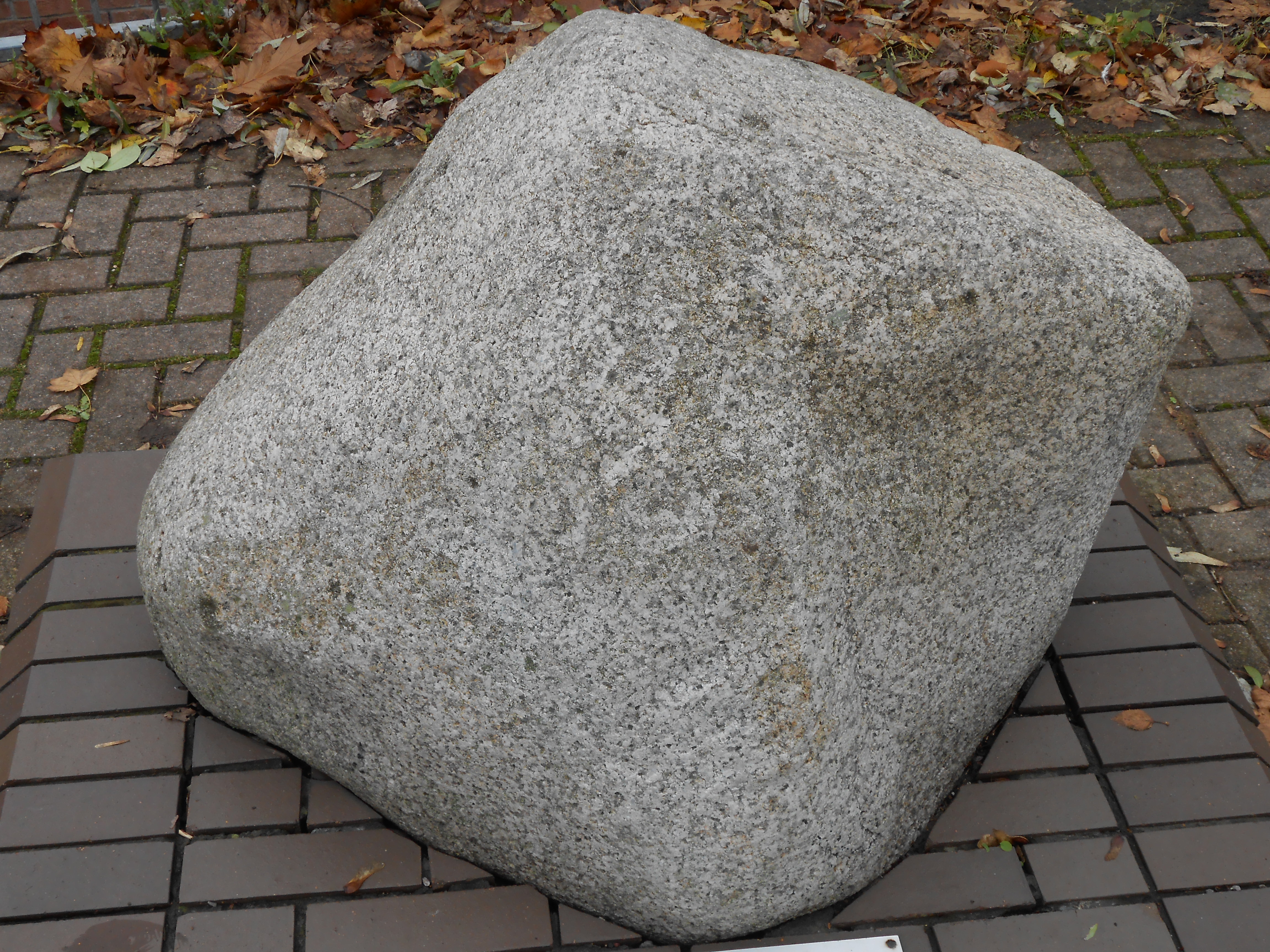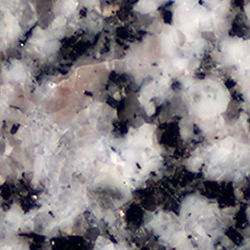Granite is a common type of igneous rock. Granites can be predominantly white, pink, or gray in color, depending on their mineralogy. The word "granite" comes from the Latin granum, a grain, in reference to the coarse-grained structure. Strictly speaking, granite is an igneous rock with between 20% and 60% quartz by volume, and at least 35% of the total feldspar consisting of alkali feldspar, although commonly the term "granite" is used to refer to a wider range of coarse grained igneous rocks containing quartz and feldspar.

Granite forms from the cooling of large magma bodies at depth in the crust, the slow cooling allowing the growth of large and interlocking mineral crystals. Compositionally, granites typically contain 55-75% silica and are commonly pale coloured with medium to coarse grained crystals discernable to the naked eye. The interlocking crystals provide cohesion which adds strength and makes them suitable for polishing without plucking of the grains. Finer grained granites were typically used for structural purposes (e.g. foundations, walling, kerbstones, setts and paving), while coarser grained and porphyritic (i.e. with large crystals usually of feldspar) varieties were valued for ornamental work. The predominance of silica and other relatively stable minerals in granite make it particularly strong and durable.
Galloway granites: The granitic rocks of the Criffel intrusive mass of southwest Scotland were extensively worked in a number of quarries at Creetown and Dalbeattie. The stone is typically grey (known as 'silver-grey') with pinkish feldspar. From the 1820s large quantities of stone were transported by sea for major dock and bridge works, for example at Liverpool and Swansea. Later it was worked for dimension stone, setts, kerbs and monumental use.

Cheshire Plain: The Cheshire Plain is a relatively flat expanse of lowland almost entirely within the county of Cheshire in North West England. It extends from the Mersey Valley in the north to the Shropshire Hills in the south, bounded by the hills of North Wales to the west and the foothills of the Pennines to the north-east. The plain is the surface expression of the Cheshire Basin, a deep sedimentary basin that extends north into Lancashire and south into Shropshire. It assumed its current form as the ice-sheets of the last glacial period melted away between 20,000 and 15,000 years ago leaving behind a thick cover of glacial till and extensive tracts of glacio-fluvial sand and gravel.
Glacial motion: Glaciers can be likened to rivers of ice and play an important role in sculpting many landscapes. Most lakes in the world occupy basins scoured out by glaciers. Glacial motion can be fast (up to 30 m/day) or slow (0.5 m/year), but is typically around 1 metre/day. Glacial motion occurs through a number of processes all driven by gravity. Basal Sliding, for example, is when the whole glacier moves. A thin film of meltwater at the base of the glacier allows it to slide on the bedrock. Another process is known as Internal Deformation. This occurs when the weight of the ice causes the deformation of ice crystals. This takes place most readily near the glacier bed, where pressures are highest. The glacier's weight becomes too much to support itself. This results in the slippage of ice layers within the glacier, the top layers moving faster than the bottom layers.
Glacial Deposition: The intense erosive action of a glacier produces vast volumes of sediments. Very fine material, called rock flour, is produced by the scraping and grinding or rock surfaces, whilst larger particles are produced by plucking and freeze-thaw. Massive rocks that fell from the valley walls onto the moving ice can also be transported, and then deposited hundreds of miles from their origins. Geographers classify glacial sediment according to it's mode of deposition. The collective name for all the sediments and debris deposited under glacial conditions is Glacial Drift. Sediments that were deposited by melting ice or by glacial streams are called Fluvio-glacial. Debris deposited directly by the glacier is known as Till.
Till: Till, in geology, unsorted material deposited directly by glacial ice and showing no stratification. Till is sometimes called boulder clay because it is composed of clay, boulders of intermediate sizes, or a mixture of these. The rock fragments are usually angular and sharp rather than rounded, because they are deposited from the ice and have undergone little water transport. The pebbles and boulders may be faceted and striated from grinding while lodged in the glacier. Some till deposits show limited organization of the fragments: large numbers of stones may lie with their long axes parallel to the flow direction of the glacier. This could provide more accurate information about flow direction than other glacial indicators. Although difficult to distinguish by appearance, there are two types of till, basal and ablation. Basal till was carried in the base of the glacier and commonly laid down under it. Ablation till was carried on or near the surface of the glacier and was let down as the glacier melted.

The range of sediment sizes and processes of deposition produce a wide range of landforms. These include moraine, eskers, drumlins, kames, and erratics. A moraine is any glacially formed accumulation of unconsolidated glacial debris. Eskers are produced as a result of running water in, on or under the glacier. They are linear mounds of sand and gravel that commonly snake their way across the landscape. Drumlins are elongated features that can reach a kilometer or more in length, 500m or so in width and over 50m in height. One end is quite step, whilst the other end tapers away to ground level. Kames are mounds of sediment which are deposited along the front of a slowly melting or stationary glacier. The sediment consists of sands and gravels, and builds up into mounds as the ice melts and more sediment is deposited on top of old debris. Erratics are large boulders that have been transported by glaciers, and often deposited a considerable distance from their origin. By establishing the origins of the erratic, by comparing its lithology with possible originating areas, it is possible to determine the direction of ice flow that brought it to its present location. This helps glaciologists to monitor and plot past ice movements across large areas.
At the given coordinates you will find a granite boulder and plaque.
To claim this cache please answer the following by sending a message or email. You may need to do a little research on the internet to answer all the questions.
1) When was this granite formed? In what geological period would that be?
2) Describe how the granite feels to touch. Include how large you think the grains and crystals might be.
3) Observe the different colours you can see in the granite? Can you explain why the granite contains different colours?
4) Can you explain how this Galloway granite got to the Cheshire Plain?
5) Given the information provided above, explain what type of landform this deposit would be?
6) Nearby, there are several other plaques and information boards. One of these boards, just inside the park, gives an old Welsh name for Nantwich and its meaning. What is this?
OPTIONAL - please take a photograph of you or your GPS with the granite (trying not to include the information on the plaque).
Please log your find as soon as you email or message the cache owner (link at the top of page). You do not need to wait for a response.
Sources:
https://en.wikipedia.org/wiki/Granite
http://www.buildingconservation.com/articles/rockofages/rockofages.htm
https://en.wikipedia.org/wiki/Cheshire_Plain
https://en.wikipedia.org/wiki/Glacial_motionhttps://www.britannica.com/science/tillhttp://www.geography-site.co.uk/pages/physical/glaciers/deposit.html